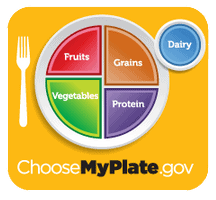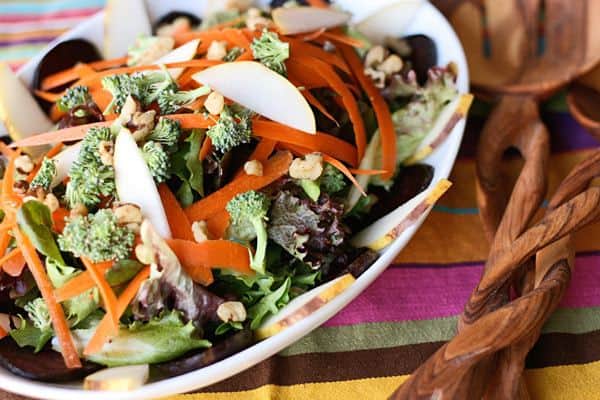This post contains affiliate links and may earn commissions on recommended products. As an Amazon Associate, I earn from qualifying purchases.
This post is part of a partnership with Seton Healthcare Family. This is the second in a series of posts covering nutrition.

I’ve written before on the benefits of meal planning and how to do it (more than five years ago, wow!). Through the years, I’ve found that this is one of the topics that comes up time and time again, whether you decide to meal plan to reduce daily dinner stress, save money, or make sure you’re eating a variety of healthy foods.
Meal planning is great for all three of those things, but today we’re going to talk about using meal planning to help you achieve balanced nutrition. Now, that doesn’t mean eating oatmeal and salads every single day, but rather ensuring you have a wide variety of foods on your plate in balanced proportions.
Remember MyPlate? This is the dietary guideline from the USDA that replaced the Food Pyramid many of us grew up with. Rather than a suggested number of servings per day, it shows how to divide your plate in a balanced way, with half your plate being fruits and veggies.

With an idea of how your plate should look, you’re ready to meal plan.
Get Recipe Inspiration
Many of us don’t have time to pore over cookbooks, Pinterest, or blogs on a regular basis, and this can put us into a recipe rut. To avoid it, sign up for email newsletters from your favorite food websites and get the recipes delivered to your inbox.
If you like magazines, rip out the recipe and post it on your fridge so you have it ready the next time you are planning. Magazines like Cooking Light and Eating Well, which have an easy-to-use recipe index on the back page, are also great online resources. If you’ve got kids, Chop Chop magazine is a great resource for seasonal, kid-friendly recipes that little hands can even help prepare.
Look for recipes that feature plenty of vegetables or be sure to choose vegetable-based sides for your main protein.
Eat the Rainbow
The more colorful your plate, the wider variety of nutrients you’re getting in your diet. By planning your meals, you can make sure to include as many colors as possible in your day-to-day and week-to-week diet.
Why are the colors so important? Different colors indicate different phytonutrients in fruits and vegetables, many of which are protective against cancer. Darker, more vibrant produce has more of these helpful nutrients, which is why dark greens like kale and collards are all the rage.
Eating seasonal, locally grown produce helps increase your consumption of these nutrients as well, as their ability to ripen on the field increases the level of nutrients. Nutrients begin to deplete the moment the produce is picked, so eating as fresh as possible is best.

Don’t worry about getting every color every single day, but do try to get dark orange and dark green produce at least twice a week. A simple glance at your week of meals will show any gaps, and you can fill in as needed.
Practice Meatless Monday
If you typically eat meat at every dinner, having a meatless meal can seem daunting. Many also worry about protein intake when choosing meatless. But the truth is, most Americans are actually eating more protein than their bodies need, and swapping out a single meat-based meal for vegetarian won’t make a large difference in your weekly intake. It’s also a better choice for the environment.
If you are concerned about protein, though, there are plenty of meatless sources, from beans and lentils to eggs and dairy or tempeh and tofu.
This Kale, Beet, and Goat Cheese Pizza is a beautiful way to have a meatless dinner, and these Butternut Squash Tacos with Black Beans are one of my family’s favorite meals. (Check out more of my vegetarian recipes!) These dishes are proof positive that you don’t need to stick to a boring salad when composing vegetarian meals.
Make Incremental Changes
For most people, a huge overnight shift isn’t going to create long-term change. If you’re completely new to meal planning, the temptation to give in and head to the nearest restaurant will likely be high. If needed, plan for a certain night of the week to eat out, to keep you on track for the rest of the week.
Start with easier recipes that don’t have a lot of ingredients or complicated preparation. Stir-fries are great dinner options because you can use practically any combination of meat and vegetables, making it perfect for getting on the table fast. (Try my Beef and Green Bean Stir Fry.) Remember that you can pull from other mealtimes for inspiration, too. Breakfast for dinner or even sandwiches can be great quick options for weeknight meals.

Remember that cooking at home is cheaper than eating out. While investing in ingredients and time now can seem difficult, especially when we’re all overworked and overstressed, it’s important to note that these changes are also an investment in your future health.
Here’s my menu plan for the week!
Sunday: Broccoli Cheese Soup (from Lighten Up Y’all)
Monday: Steak Lettuce Wraps
Tuesday: Chicken Tikka Masala with broccoli
Wednesday: Spaghetti Squash Taco Bowls
Thursday: Lentil Sloppy Joes
Friday: Homemade pizza with salad
Saturday: Clean-out-the-fridge stir fry
For more information on healthy eating, check out the Seton Healthcare Family on Facebook, Twitter, Pinterest, and Instagram, or follow Dell Children’s Medical Center on Facebook, Twitter, and Pinterest.
Thanks to Lauren Brauer, Lead Registered Dietitian for the Texas Center for the Prevention and Treatment of Childhood Obesity at Dell Children’s Medical Center, for her help in compiling this article.

About Megan
I learned how to cook by exploring seasonal ingredients, and you can too! Meal time shouldn’t be stressful or complicated, and with fresh ingredients and easy methods, I’m here to help you enjoy the time spent in the kitchen. Read more…













I started seriously meal-planning during my unemployed stint, more to keep a careful eye on all the food and how fast we were going through it. One thing we all noticed was that we’ve been eating a lot better lately, and not relying so much on convenience foods or even eating out as frequently!
@Rachel It’s crazy! Even though I have been meal planning off and on since before I got married, any week we DON’T plan is a disaster. Fail to plan, plan to fail!
I began seriously to plan better meals after a long period of unemployment, the food is very much influence on health. Maybe I’m more focused on it than, thanks for share !